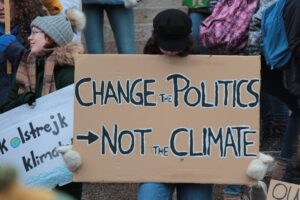Carbon markets are high on the agenda at the UN’s COP26 climate change conference. Carbon Market Watch’s Gilles Dufrasne has prepared this handy guide to explain the issues at stake related to Article 6.

The next UN climate change conference (COP26) kicks off this weekend. One of the key items up for negotiation is the regulation of the carbon markets established under the Paris Agreement. These discussions have dragged on for over five years now, and they remain highly contentious.
Regulation rather than creation
These negotiations are not about setting up new markets but are about regulating those already authorised under the Paris Agreement. Article 6 establishes the right of countries to exchange emission reductions on a bilateral or multilateral basis through so-called “cooperative approaches”. This means that one country would be able to count cuts achieved in another country by paying that country for them.
The bottomline is that the trading of emission reductions will happen regardless of whether there is a deal on Article 6 at COP26 or not. In fact, three countries are already making concrete plans for this to happen. Switzerland has signed partnerships with Peru, Ghana, Senegal and Georgia. Japan is continuing to further its collaboration with 17 partner countries under its Joint Crediting Framework. South Korea recently announced an increased emission reduction target and is in talks to conclude agreements with Vietnam, Peru, Sri Lanka and Myanmar (paywall link).
A sellers’ market
Around 120 countries have included the use of carbon markets in their nationally determined contribution (NDC). This represents about a third of global emissions, according to a tracker developed by the World Resources Institute (WRI). But this notably includes very few potential buyer countries, and you cannot have a market made up primarily of sellers. Therefore, it is unclear how much demand there will really be for UN-regulated carbon markets.
Private sector playground
Most of the activity today, and possibly for at least a few more years, is concentrated in the private sector. Private companies used about 100 million carbon credits in 2020 (representing 100 million tonnes of emissions). The demand, although relatively small for now, is rising fast as companies announce net-zero and climate neutrality targets. While the Article 6 negotiations will be the centre of attention during the COP26, private sector announcements made on the sidelines could have a big impact as well.
The voluntary use of carbon offsets by private companies has been expanding massively over the past couple of years. We have almost lost track of the number of “carbon neutral”, “net zero”, and “climate positive” private sector announcements being made. Nearly all of these rely on the use of carbon credits to supposedly compensate for emissions.
While carbon credits can play a positive role in channeling private finance to projects that benefit the climate, the current unregulated use of the carbon market enables large-scale greenwashing to occur. One particularly ludicrous and brazen example is that of so-called carbon-neutral fossil fuels, which we expose in our latest investigative report, ‘Net-zero pipe dreams’.
This is why many are demanding that Article 6 negotiations provide guidance for effectively regulating the so-called “voluntary carbon market”, aka offsetting. But judging by the negotiations so far, it’s clear that some countries want to stay out of this as they prefer to leave private sector action unregulated .
As things stand, it is highly unlikely that any of the Article 6 rules will directly apply to voluntary offsetting. Nevertheless, an agreement at COP could still impact private sector activity by sending a political signal for what is or is not acceptable. This is particularly the case when bearing in mind that many voluntary market rules and methodologies are largely drawn from UN rules and methodologies. In fact, most projects and methodologies under the voluntary market today are connected to an old UN market (the Clean Development Mechanism, or CDM) or a forest conservation programme (the REDD+ framework), despite the latter having been established as a climate finance mechanism that was not intended for compensation.
Various initiatives outside of the United Nations Framework Convention on Climate Change (UNFCCC) have been launched to attempt to regulate the voluntary carbon market, including the Taskforce on scaling the voluntary carbon market, and the voluntary carbon market integrity initiative.
Credit where it’s not due
Carbon markets are currently in a paradoxical situation in which there is both too much and too little supply. Both UN and voluntary markets are oversupplied with very low quality credits. The CDM could issue billions of credits (known as CERs) at very low prices if there was more demand. CERs can currently be found for around $1 per tonne of CO2. On the voluntary side, the surplus is significant and growing.
At the current rate, even if a freeze on new credits started today, it would take about five years for companies to use up all the available voluntary credits.
The other side of the story is that companies with integrity are struggling to find quality credits. There are currently virtually no quality emission removal credits available, and few credits that actually correspond to real and accurately quantified tonnes of CO2e reduced.
This is why, while countries cannot directly regulate voluntary activities, it is important that they both put an end to the generation of low quality credits under UN mechanisms, and refuse to continue using old, junk credits. This should send a clear signal to voluntary market participants that the time for investments has come, and that $1-10 credits are not credible.
Clean Development Mechanism: Back to the future
One of the most contentious negotiation items under Article 6 is to decide what will happen to old credits and projects, generated and registered under the Kyoto protocol’s carbon markets, in particular the Clean Development Mechanism (CDM). The risk clearly exists that billions of old credits would enter the new market, and have a negative impact on climate action, market activity, and the market’s reputation. Some countries, notably those where most of the old projects were implemented, would like to count legacy credits toward the new targets under the Paris Agreement.This would not only undermine future climate targets but could even lead to an overall increase of greenhouse gas emissions.
While this will be discussed as part of the Article 6 negotiations, the CDM will also be the focus of discussions under the Kyoto protocol process. Last year, the CDM Executive Board decided that it could no longer issue carbon credits for reductions after 2020, nor register projects, in the absence of guidance from countries. This is because the Kyoto protocol does not provide for the continuation of the system beyond this date.
For a more detailed discussion on the future of the CDM, see our full article here.






